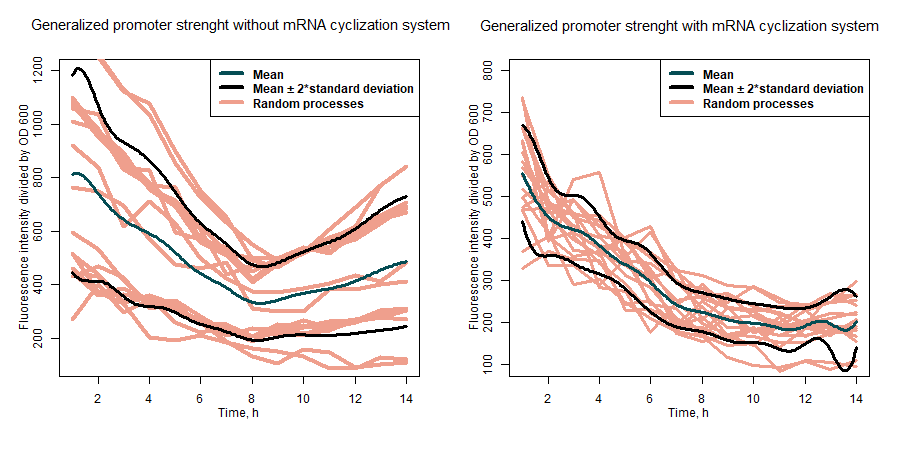Part:BBa_K3904217
mRNA cyclization system
To assure continuous and efficient naringenin production, we had to guarantee the proper expression of naringenin synthesis enzymes in our probiotic strains. To reach the maximum efficiency of the natural synthesis pathway, we decided to manipulate the expression rates of these proteins by finding the promoters of optimal strength for the expression of each of these enzymes using pTRKH2 vector. In addition to that, we also introduced an mRNA cyclization system to this project. The circularization of mRNA molecules is supposed to improve the fraction of full-length proteins among synthesized polypeptides by selectively translating intact mRNA and reducing abortive translation.
Introduction
Vilnius-Lithuania iGEM 2021 project AmeByelooks at amebiasis holistically and comprehensively, therefore target E. histolytica from several angles: prevention and diagnostics. Our team's preventive solution consists of probiotics engineered to produce naringenin - an antiprotozoal compound. Two strains of genetically modified microorganisms were chosen as the main chassis - world-renowned Lactobacillus casei BL23 (Lactobacillus paracasei) and Escherichia coli Nissle 1917. Furthermore, the team made specific gene deletions to enhance naringenin production and adapted a novel toxin-antitoxin system to prevent GMO spreads into the environment. The diagnostic part includes a rapid, point of care, user-friendly diagnostic test identifying extraintestinal amebiasis. The main components of this test are aptamers specific to the E. histolytica secreted proteins. These single-stranded DNA sequences fold into tertiary structures for particular fit with target proteins.
Contents
Usage and Biology
A synthetic mRNA cyclization system enables translation only when both ends of mRNAs are present and followed by circularization based on sequence-specific RNA–RNA hybridization. This system should improve the fraction of full-length proteins among all synthesized polypeptides by selectively translating intact mRNA and reducing abortive translation [1].
Part characterization
Promoter strength was estimated by measuring how intensively the nissle transformants can produce GFP under the promoter of interest. Fluorescence intensity was evaluated by dividing the intensiveness of the signal by the OD600 of the medium during the course of 6 hours (Figure 1). The greater ratio would indicate the stronger promoter (Table 1). The data were compared between all the promoters of our interest and the sequences demonstrating required expression rates were selected for the construction of naringenin synthesis cassete. The same evaluation strategy was applied to measure the effectiveness of mRNA cyclization system, which in our particular case did not show the expected potential to improve the efficiency of our system (Figure 2)[1].
Figure 1: first graph - comparison of the strength of all target promoters; second graph - the strength of all target promoters compared to p-slpA.
Table 1: the evaluation results of the promoters without mRNA cyclization system.
| Promoter | Absolute value of fluorescence/OD600 at the midpoint of growth | Promoter strength in comparison to p-slpA |
|---|---|---|
| BBa1033225 | 383.99 | 0.76 |
| BBa1033222 | 227.79 | 0.45 |
| BBa1033220 | 295.25 | 0.58 |
| P-slpA | 508.22 | 1.00 |
| J23118 | 176.43 | 0.35 |
| J23117 | 155.74 | 0.31 |
| J23115 | 135.46 | 0.27 |
| J23114 | 175.06 | 0.34 |
| J23113 | 180.56 | 0.36 |
| J23107 | 253.16 | 0.50 |
| J23106 | 237.59 | 0.47 |
| J23103 | 178.62 | 0.35 |
| J23102 | 187.82 | 0.37 |
| J23101 | 226.14 | 0.44 |
Figure 2: comparison of general promoter strength with and without mRNA cyclization system.
Sequence and Features
- 10COMPATIBLE WITH RFC[10]
- 12INCOMPATIBLE WITH RFC[12]Illegal NotI site found at 116
- 21INCOMPATIBLE WITH RFC[21]Illegal BamHI site found at 204
- 23COMPATIBLE WITH RFC[23]
- 25COMPATIBLE WITH RFC[25]
- 1000COMPATIBLE WITH RFC[1000]
References
- Yang, J., Han, Y.H., Im, J. et al. Synthetic protein quality control to enhance full-length translation in bacteria. Nat Chem Biol 17, 421–427 (2021). https://doi.org/10.1038/s41589-021-00736-3
| None |



